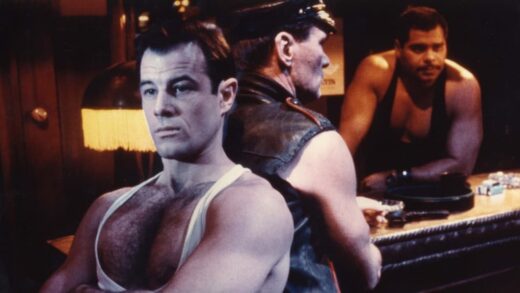Popeye (1980)
![]()
Popeye (1980) Directed by Robert Altman
Breathtakingly atrocious. Ugly. Exasperating. And affectedly tacky. Robert Altman’s live-action cartoon Popeye is arguably the only film worthy of multiple vituperations and still managing to be uncommonly fascinating. This unclassifiable monstrosity of a film based on the celebrated comic book character created by cartoonist E. C. Segar has all the makings of an extraordinary production, features a uniformly spot-on cast, has expert Italian cinematographer Giuseppe Rotunno, and has none other than one of the titans of new Hollywood cinema at the helm. What could go wrong with so many prestigious people behind this project? Well, the answer is, absolutely everything. Nevertheless, the aforementioned artists are exempt from culpability, because to be fair, it is thanks to them alone that this cinematic fiasco is at least watchable.
In an objective autopsy, the authors of the crime would be the cartoonist and author Jules Feiffer -who should have stayed in the animated medium, where his talent shone- and the unfortunate co-production of Paramount Pictures with Walt Disney Productions. Feiffer writes Popeye’s screenplay with noble intentions, it is lighthearted, cheerful and playful, but it is abundantly clear that his literary conceptions are designed for a cartoon, not for a live-action picture. His cluelessness regarding the limitations of a live action film leads Robert Altman to undertake an unfilmable endeavor. The storytelling rhythms Feiffer suggests in his technically animated screenplay are simply incompatible with the rigidity of the real world. The two major studios responsible for this film are even more alienated from what is possible to film than Feiffer’s script; the consequences of willfully carrying out a film that suffers from tangible artistic anomalies are now history. Popeye is one of the most grotesque experiences in the history of cinema, and it is the weirdest movie ever to come out of a Hollywood studio.
The story is moderately enjoyable, Popeye the sailor man (Robin Williams) arrives in the fictional coastal town of Sweethaven, a quirky place where you pay more taxes than in a bureaucratic dystopia. Popeye is in desperate search of his missing father, whom he has been looking for for a long time after he was abandoned as a child. In Sweethaven he meets the delightfully annoying Olive Oyl (Shelley Duvall), hamburger maniac Wimpy (Paul Dooley) and the barbarous Bluto (Paul L. Smith). Like a sort of Nashville for children, Robert Altman crafts this story with a fragmented structure that then collectively coalesces. Aesthetically, the film is not a debacle as much as the overall lackluster story and arrhythmic music; Rotunno’s pallid cinematography arguably lends an idiosyncratic quality to the seaside setting. Nonetheless, it remains incongruous with the narrative ugliness that pervades its little merits. But if we are talking about incongruities, then there is nothing more incongruous than the awkward imbalance between the musical domain of the film and the cartoonish parameters of the slapstick comedy. The gags are unproductive with the shapeless musicality of the staging – which is almost invariably theatrical – and let’s face it, there is not a single gag that is genuinely funny.
The world Altman establishes is that of a cartoon, that’s what the script gives him to put in front of the camera, but the attempt to marry the thrilling irrationality of the animated medium with the physical coherence of a live action film leaves glaring errors that prove to be a detriment to the entertainment. It’s more of a strange movie than a fun one. Feiffer’s feeble and contradictory writing feels more like an adaptation of Max Fleischer’s Popeye than a proper live-action adaptation. The laws of animation govern the filming of Popeye – I suspect Altman’s bold and rebellious filmmaking inclinations prompted him to embrace this crude avant-gardism – and thus collide with the laws of physics in the real world, no matter how many special effects or optical tricks are employed, what must be done is to adapt the laws of animation to those of a live-action film, not the other way around.
The cast is superb, and thankfully the filmmakers are aware of this, otherwise the whole movie would have been a tasteless joke. Robin Williams, although he looks a bit bewildered with those amorphous giant forearms, plays Popeye with admirable accuracy, Williams’ Popeye is plain endearing. The tyrannical and brutish Bluto played by Paul L. Smith is unquestionably the animated character incarnate. All are in flesh and blood almost identical to the comic book characters. But if there is one who is not identical but exactly the same, it is Shelley Duvall’s Olive. The funniest thing about Duvall’s performance is that she’s having a blast acting out the character’s insecurities. She is truly memorable, effervescently exasperating and downright hilarious.
I have a feeling that at some point during shooting the filmmakers realized that the overall scheme of the film was a mess and that the only thing that would invigorate the screen would be the actors. For that very reason, the comedic ubiquity of the actors is felt in every unsuccessful frame. Clearly, Popeye is a legitimate endeavor, it wants to be a Hollywood musical for the whole family, it aims to be a live-action cartoon and it aspires to be a wacky comedy. In the end, however, it fails to reconcile any of these, only managing to sound like a cacophony of an audiovisual aberration.






